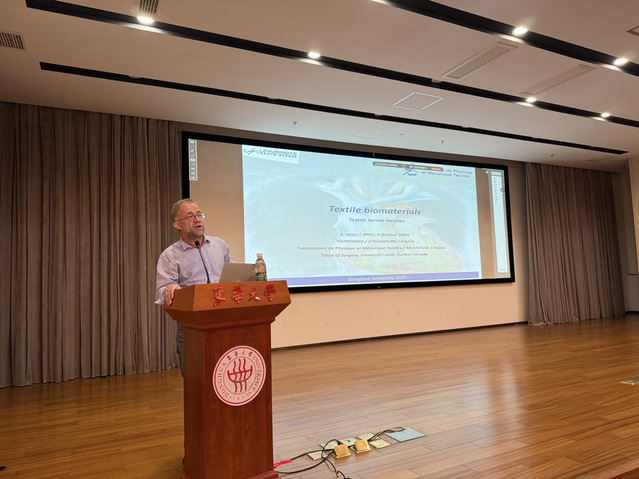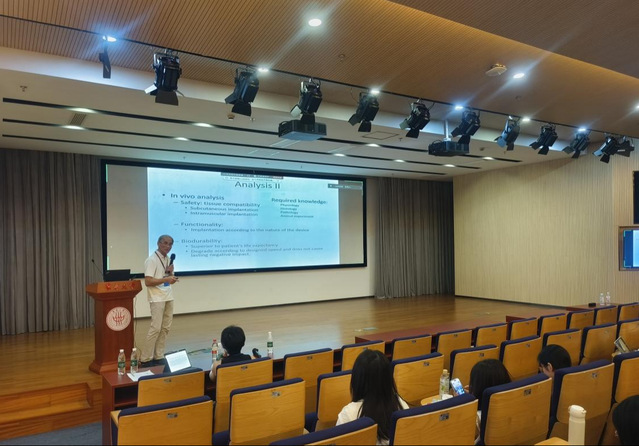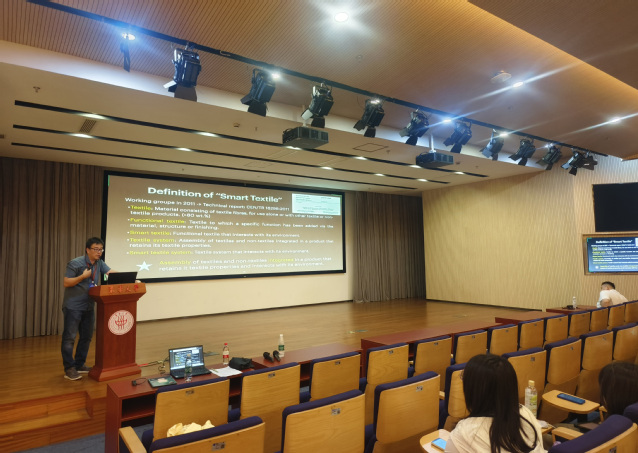2025 Shanghai International Textile Graduate Summer School Teaching Briefing
Issue 3 July 2, 2025 E-mail: fzsqxx@dhu.edu.cn
2025 organizing committee of Shanghai Textile Graduate International Summer,
written by: Han Qi
On July 2nd, Professor Frederic Heim from he University of Haute-Alsace in France, Professor Ze Zhang from Laval University in Canada, and Professor Tao Xuayan from Ecole Nationale Supérieure d'Ingénieurs des Textiles (ENST) delivered excellent academic reports.
Professor Heim introduced the development of modern synthetic patch repair technology for hernia treatment. The patch material has undergone a century-long evolution, from the early rigid non-woven patches to the modern high-performance textile structures. The new patches are classified by pore size and weight. Lightweight patches can improve the patient's mobility. The Heim team has developed bioabsorbable materials that can be absorbed by the human body within 24 months, reducing long-term foreign body reactions.
Professor Heim emphasized that the elastic modulus of the patch needs to match the characteristics of the human abdominal wall to reduce complications such as fibrosis. Future research directions include the development of smart materials and personalized treatment plans, such as combining anti-adhesion barrier technology to optimize the balance of biocompatibility, mechanical strength, and patient comfort. This research provides important guidance for the advancement of hernia treatment towards precision and safety.

(Professor Frederic Heim)
Professor Ze Zhang systematically introduced the core analytical testing technologies in the field of biomedicine, with a particular focus on surface and microstructure characterization techniques. He elaborated on the application of contact angle measurement instruments in the analysis of material hydrophilicity and hydrophobicity, as well as the advantages of SEM, TEM, and AFM in observing nano-scale morphology. In terms of component analysis, he detailed the roles of XPS, FTIR, and mass spectrometry in detecting the chemical composition of materials.
Given the uniqueness of biomedical materials, Professor Ze Zhang emphasized the biocompatibility evaluation system, which includes cell adhesion and proliferation detection, as well as molecular-level gene and protein analysis techniques, combined with numerous research cases, vividly demonstrating the importance of modern multimodal characterization in biomedicine.

(Professor Ze Zhang)
Professor Xuyuan Tao introduced the development and application of smart textiles, and pointed out that smart textiles can sense and respond to environmental changes, and are classified into passive, active and highly intelligent categories. The integration level ranges from simple electronic components to fully textile-based components. Currently, the market potential of smart textiles is huge and they are widely applied. In terms of materials, color-changing materials, phase-change materials, shape-memory alloys, etc. are key breakthroughs. For example, shape-memory alloy wires can be sewn into fabrics to make adaptive textiles; phase-change material microcapsules can absorb heat to optimize the wearing experience, etc. The smart textile system requires everyone to actively explore and promote its innovative applications in fields such as healthcare, sports, and fashion. In the future, it may become an important growth point for the textile industry.

(Professor Xuyuan Tao)

